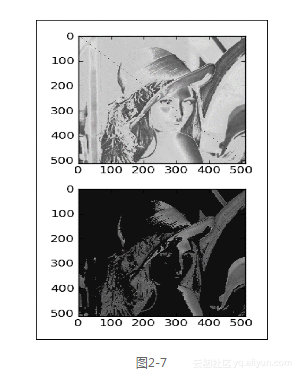《Python数据分析》一2.10 用布尔型变量索引NumPy数组
2023-09-11 14:17:44 时间
本节书摘来自异步社区《Python数据分析》一书中的第2章,第2.10节,作者【印尼】Ivan Idris,更多章节内容可以访问云栖社区“异步社区”公众号查看
布尔型索引是指根据布尔型数组来索引元素的方法,属于花式索引系列。因为布尔型索引是花式索引的一个分类,所以它们的使用方法基本相同。
下面用代码(详见本书代码包中的boolean_indexing.py文件)具体演示其使用方法:
import scipy.misc import matplotlib.pyplot as plt import numpy as np lena = scipy.misc.lena() def get_indices(size): arr = np.arange(size) return arr % 4 == 0 lena1 = lena.copy() xindices = get_indices(lena.shape[0]) yindices = get_indices(lena.shape[1]) lena1[xindices, yindices] = 0 plt.subplot(211) plt.imshow(lena1) lena2 = lena.copy() lena2[(lena lena.max()/4) (lena 3 * lena.max()/4)] = 0 plt.subplot(212) plt.imshow(lena2) plt.show()
上述代码利用一种特殊的迭代器对象来索引元素,下面进行简单说明。
1.在对角线上画点。
这类似于花式索引,不过这里选择的是照片对角线上可以被4整除的那些位置上的点。
def get_indices(size): arr = np.arange(size) return arr % 4 == 0
然后仅绘出选定的那些点。
lena1 = lena.copy() xindices = get_indices(lena.shape[0]) yindices = get_indices(lena.shape[1]) lena1[xindices, yindices] = 0 plt.subplot(211) plt.imshow(lena1)
2.根据元素值的情况置0``。
选取数组值介于最大值的1/4到3/4的那些元素,将其置0。
lena2[(lena lena.max()/4) (lena 3 * lena.max()/4)] = 0
3.两幅新照片如图2-7所示。

Python机器学习数据建模与分析——Numpy和Pandas综合应用案例:空气质量监测数据的预处理和基本分析 本篇文章主要以北京市空气质量监测数据为例子,聚集数据建模中的数据预处理和基本分析环节,说明Numpy和Pandas的数据读取、数据分组、数据重编码、分类汇总等数据加工处理功能。同时在实现案例的过程中对用到的Numpy和Pandas相关函数进行讲解。
异步社区 异步社区(www.epubit.com)是人民邮电出版社旗下IT专业图书旗舰社区,也是国内领先的IT专业图书社区,致力于优质学习内容的出版和分享,实现了纸书电子书的同步上架,于2015年8月上线运营。公众号【异步图书】,每日赠送异步新书。
相关文章
- sublime配置python
- 关于python的二维数组
- Python 卸载python
- Python fire官方文档教学(自动生成命令行,个人觉得意义不大,不如argparse)
- 【华为OD机试真题 python】硬件产品销售方案【2023 Q1 | 200分】
- [转]Python numpy函数hstack() vstack() stack() dstack() vsplit() concatenate()
- Python-Numpy中那些通过条件判定(函数迭代运算)去选取元素或重置元素的方法(函数)
- 13 python - for循环
- Python Selenium其他使用方法
- 基于Python(Django)+SQLite实现(Web)校园助手【100010159】
- python == 符号
- Jenkins持续集成实战之Jenkins构建Python项目提示:'python' 不是内部或外部命令,也不是可运行的程序。
- Python自动发送邮件时报smtplib.SMTPConnectError: (550)错误
- 轻松自动化---selenium-webdriver(python)
- python和numpy matplotlib版本匹配,以及安装指定版本库
- Python 常见问题 之 from .cv2 import * ImportError: numpy.core.multiarray failed to import
- Python 工具 之 Windows 上 python 虚拟环境的搭建与简单使用的相关说明
- 【Python注意事项】如何理解python中间generator functions和yield表情
- 【python 学习】——pycharm终端解释器和Python解释器配置
- Selenium4 Python实现Page Factory设计模式,python新的定位方法
- Python中有关OS操作的一些基础编程

